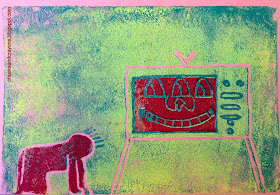I think this has been the favorite assignment of the school year, for both the students and I. Out of about 90 students, only 5 or 6 really didn't like idea of making multiple prints. A large majority of the students had successful outcomes, and from my point of view, they were exposed to some recent Art History AND a new process. - I have tried to approach Art One as a survey course with a focus on observation and communication through various processes.
At the end of April, I was out on a field trip, so I left this video and drawing prompt with my substitute. This was a great lead up to the Reduction Print assignment the following week. In fact, a few students expanded on the idea they started during this class.
Next, I introduced Keith Haring with an "interactive" powerpoint. It was interactive in a sense that students were able to hear Haring's voice, talking about working in the subway. And, after discussing how line was used to create symbols, students were given a slide of nine of Haring's pictographs, and wrote what they thought each could represent.
We also talked about how Haring used his art to bring awareness to the AIDS epidemic as well as anti-drug campaigns, which were big topics of the time. I then provided students with a short biography and place to sketch ideas. The biography proved to be super helpful for those students who missed the background information class.
- Sketch
- Create two copies on 6x9 newsprint
- On one copy, use color pencils to separate the image into three sections/ colors.
- Use the second copy to transfer the image onto styrofoam.
At this point I showed another power point explaining the steps of printmaking. As I used the power point, I also did a demo, so students could see and hear what was going on in "real time."
- Create 6 prints, using different ink and color papers, of your line drawing.
- Ink and register foam over the previous prints.
Sorry images are sideways.
- Reduce and print a second time.
Preparation and conversation were key to this lesson.
Beforehand, I did the project myself. The images from the demo are from when I tried it out. I wanted to make sure I knew what I was doing, and anticipate any pitfalls. I also cut paper to size ahead of time. To save the desks from massive messes, I cut craft paper to about the same size as the table surface and we continued to reuse them. (I have even saves the pages for future collages!)
The other lifesaver was this drying rack.
I showed students how to load it from the bottom and when a rack was full, pull down the next. Each morning, I collected the dry prints and placed them in a shoe box designated for each class.
Through this reduction process (and daily collection of work) I was able to talk to students about their process and decisions in a way that I have never been able to before. I try to wrap up most assignments with self evaluations and reflections, and through those I was able to see that what we discussed (and what they have learned this year (especially about color and contrast)) was synthesized and used.
I am so proud of what my students have accomplished here. Check out some of their results.
Why do you see 4 of the same?
Students were asked to pass in 4 of their 6 prints. Students were then evaluated on studio performance (effort, including clean up), creativity, craftsmanship, color choices, line/ symbol in it's clarity of communication, and composition.
Others took the opportunity to make statements about our society in the spirit of Keith Haring.
So cool.
Send me a message if you would like any of the power points or any other information.
Thanks for reading!




















do you still have the powerpoint? or the audio?
ReplyDelete